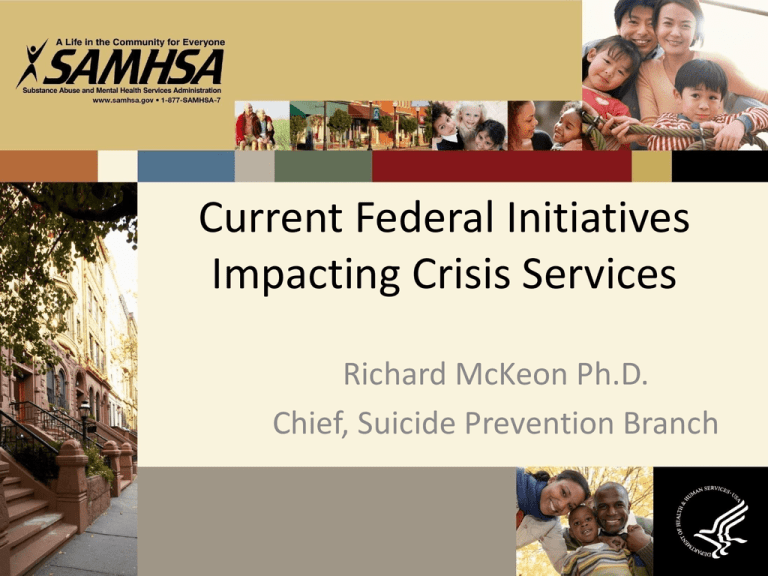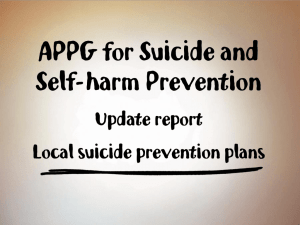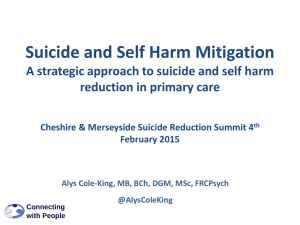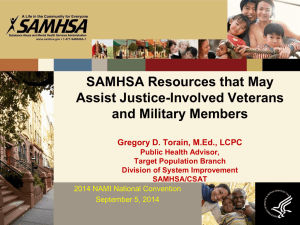Current Federal Initiatives Impacting Crisis Services
advertisement

Current Federal Initiatives Impacting Crisis Services Richard McKeon Ph.D. Chief, Suicide Prevention Branch Current SAMHSA initiatives • Comprehensive Crisis Systems • Section 223 of the Protecting Access to Medicare Act (aka Excellence in Mental Health Act) • National Suicide Prevention Lifeline-expansion to 24 hour crisis chat coverage • Focus on mobile outreach, Emergency Department Care, and Care Transitions/post discharge follow up Comprehensive Crisis Systems • SAMHSA interested in how comprehensive crisis systems are designed, funded and staffed • While there are models in different states, comprehensive crisis systems are not generally available across the United States • This leads to huge pressures on Emergency Departments and law enforcement, poor outcomes. Comprehensive crisis services • Growing evidence base on the effectiveness of comprehensive crisis services, particularly as diversions from hospitalization or incarceration • Growing evidence of cost-effectiveness in ROI studies. • Most crisis services have had to depend on multiple funding sources “collaborative funding”. Recent SAMHSA crisis initiatives • Paper-Crisis Services, Effectiveness, Cost Effectiveness and Funding Strategies • Financing study of post discharge follow up • Financing study of telemental health , including financing of crisis services • Incorporation of postdischarge follow up/care transitions as a focus in GLS and NSSP grants Financing Crisis Services • Private 3rd party insurance has been weak. • Uninsured a major financing issue • Frequently a combination of state funds and Medicaid, also SAMHSA block grant funds. • 36 states using Medicaid to fund crisis services • 12 use the Medicaid clinic option, 21 the Rehabilitation option, 3 Targeted case management, waivers 4-1115,6-1915b,51915c Financing Crisis Services • States often use several Medicaid streams • SAMHSA paper focuses in detail on Illinois, Massachusetts, Maine, Michigan, Missouri, Tennessee, Texas, and Wisconsin • States have controlled costs by basing several services in the same facility such as CSU and walk-in in Tennessee Components of Comprehensive Crisis Systems • • • • • • • • Mobile crisis response teams Crisis stabilization beds Hotlines and warmlines Crisis respite Psych emergency/walk in Post crisis follow up engagement and support Role of peers Report commissioned on crisis components Texas Mental Health and Substance Abuse Crisis Service Redesign • Stakeholders critical of timeliness and of training and competency determination of crisis providers (e.g. no harm contracts) • Also of lack of availability of alternatives to hospitalization or incarceration, of responses to intoxicated persons, of coordination with law enforcement, and with oversight to monitor effectiveness • Transport issues Texas Crisis Service Redesign • Identified core services including crisis hotline, psychiatric emergency services with extended observation services 23-48 hours, crisis outpatient, community crisis residential, mobile outreach, CIT or equivalent • All LMHA needed to have or contract with hotlines and needed affiliated MCOT • Major investment ($89m) in crisis services paid for itself within 4 years Section 223 of Protecting Access to Medicare Act • November 12th Listening Session • Creates criteria for certified community behavioral health clinics • Provides $25,000,000 that will be available to states as planning grants for the two year pilot. Only states that receive a planning grant will be eligible to apply for the pilot • Stipulates that 8 states will be selected to participate in the pilot. Section 223 • Selected states will receive a 90% FMAP for all of the required services provided by the Certified Community Behavioral Health Clinics • Under the scope of services is listed: • Crisis Mental Health Services, including 24 hour mobile crisis teams, emergency crisis intervention services, and crisis stabilization • Medicaid demonstration project with recs from Sec. HHS to Congress at conclusio MISSED OPPORTUNITIES = LIVES LOST • The numbers of people being seen in EDs for a suicide attempt has been increasing, while the proportion hospitalized has been decreasing (Larkin, 2008) • Only 48% of adult Medicaid recipients seen in EDs for a suicide attempt received a mental health evaluation and only 52% received outpatient follow up within 30 days MISSED OPPORTUNITIES = LIVES LOST • For youth age 10-19 who receive Medicaid and were seen in the ED for a suicide attempt, almost 73% were discharged BUT only 39% received a mental health evaluation, and 43% received outpatient treatment within 30 days • Best predictor of outpatient follow up was recent outpatient mental health treatment EMERGENCY DEPARTMENT F/U • Fleischmann et al (2008) – Randomized controlled trial; 1867 Suicide attempt survivors from five countries (all outside US) – Brief (1 hour) intervention as close to attempt as possible – 9 F/u contacts (phone calls or visits) over 18 months Results at 18 Month F/U Percent of Patients 3 2.5 2 1.5 1 0.5 0 Died of Any Cause Usual Care Died by Suicide Brief Intervention • Motto 1976: 389 pts. refusing outpt. assigned to “no “contact” (up to 24 letters over 5 years) Contact group sig. fewer suicides than nocontact group (particularly first 2 yrs) • Carter et al, 2005: Postcards to 378 attempters, varying monthly intervals, 12 mos. after d/c Approx 50% reduction in attempts major international efforts have reduced suicides • Taiwan-nationwide effort to intervene with those who have attempted suicide, 50,000+ • 63.5% reduction in suicide attempts among those who accepted the program. Those who refused but then persuaded 22% reduction. • English National Strategy- 24 hours crisis care strongly associated with reduction in suicides. • Proactive outreach and discharge f/u 7 days National Strategy for Suicide Prevention Objective 8.4 Promote continuity of care and the safety and wellbeing of all patients treated for suicide risk in emergency departments or hospital inpatient units. • There is substantial evidence that discontinuities in treatment and fragmentation of care can increase the risk for suicide. Death by suicide in the period after discharge from inpatient psychiatric units is more frequent than at any other time during treatment.92 NSSP Objective 8.8 • NSSP Objective 8.8-Develop collaborations between Emergency Departments and other health care providers to provide alternatives to emergency department care and hospitalization when appropriate, and to promote rapid follow up after discharge. Crisis Center Role in Follow-Up GLS/NSSP grant requirement Several crisis centers funded for follow up SAMHSA Theory of Change Crisis Centers Uniquely Positioned 24-hr access to staff trained in suicide assessment (RA, support, referrals, safety plan, and emergency rescue) Connect directly to local crisis teams Facilitate linkage/maintain linkage Provide telephonic support in rural areas Avert unnecessary ED visits/Reduce ED burden Lifeline/SAMHSA Investment in Follow-Up SAMHSA Follow-Up Grants Since 2008 – 44 follow-up grants to 41 centers Ongoing Follow-Up Evaluation Truven ROI Lifeline Network Resources Follow-Up Guidance for Crisis Centers Crisis Center-Emergency Department Toolkit Background research, barriers to implementation, sample proposals, and consent forms Safety Planning Training Case studies, partnership planning exercises, letter templates, fact sheets, meeting tools, and sample materials Lifeline/ED Collaboration Paper Approaches to follow-up, templates – safety planning, consent forms, sample crisis center MOUs with local EDs Video, templates, MY3 App General Follow-Up Training Module (NYSOMH) Reports From Lifeline Centers: ED Follow-Up Mental Health Services, Cleveland (2010-11) 46/49 patients consented/All contacted 100% reported lower risk 72% followed safety plan 50% contacted referrals No reported attempts or readmissions The Effort, Sacramento (2010-11) 74/75 patients consented/All contacted 100% reported lower distress 100% followed safety plan 76% contacted referrals No reported attempts or readmissions Reports From Lifeline Centers: Inpt. Follow-Up LifeNet, NYC (2010-11) 183 referred 55% contacted 100% of those contacted followed safety plan 100% of those contacted linked to referrals No reported attempts or readmissions Contra Costa, CA 59 attempt survivors after hospital d/c 100% reported f/u calls were “helpful” or “somewhat helpful” 98% reported calls made them feel more safe and connected No person attempted suicide over 8 months States with Systems Support TEXAS State funded EDs must partner with the state funded safety net centers for each county or region Safety net centers must operate a 24-hour hotline, provide follow-up, mobile crisis and residential treatment At least 85% of patients must be contacted within 7 days of discharge WISCONSIN Requires local law enforcement gain clearance from crisis center before involuntary detentions Crisis centers required to follow-up with patients discharged from ED MAINE Requires continuity of care among behavioral health agencies Provides a state-wide crisis hotline Crisis centers provide services and partner with EDs, inpatient units, mobile crisis teams & jail facilities Other Major Federal and Private Initiatives • • • • NIMH ED SAFE VA Safe VetVA/DOD Practice Guidelines CMS Community Care Transition grantsreducing readmissions-readmission penalty • Excellence in Mental Health Act/Section 223 • We know what needs to be done, now we must transform the systems with sustainable funding streams Contact information: Richard McKeon, Ph.D., M.P.H. Branch Chief, Suicide Prevention, SAMHSA 240-276-1873 Richard.mckeon@samhsa.hhs.gov










